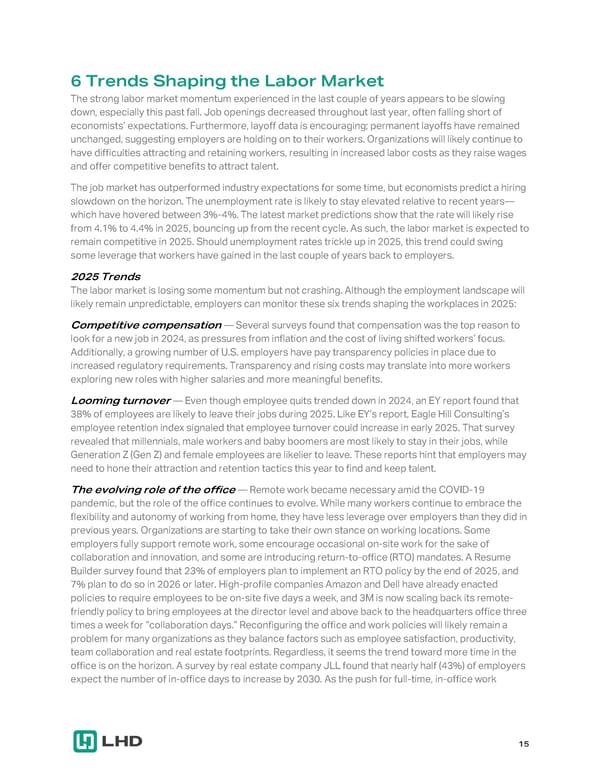6 Trends Shaping the Labor Market The strong labor market momentum experienced in the last couple of years appears to be slowing down, especially this past fall. Job openings decreased throughout last year, often falling short of economists’ expectations. Furthermore, layoff data is encouraging; permanent layoffs have remained unchanged, suggesting employers are holding on to their workers. Organizations will likely continue to have difficulties attracting and retaining workers, resulting in increased labor costs as they raise wages and offer competitive benefits to attract talent. The job market has outperformed industry expectations for some time, but economists predict a hiring slowdown on the horizon. The unemployment rate is likely to stay elevated relative to recent years— which have hovered between 3%-4%. The latest market predictions show that the rate will likely rise from 4.1% to 4.4% in 2025, bouncing up from the recent cycle. As such, the labor market is expected to remain competitive in 2025. Should unemployment rates trickle up in 2025, this trend could swing some leverage that workers have gained in the last couple of years back to employers. 2025 Trends The labor market is losing some momentum but not crashing. Although the employment landscape will likely remain unpredictable, employers can monitor these six trends shaping the workplaces in 2025: Competitive compensation — Several surveys found that compensation was the top reason to look for a new job in 2024, as pressures from inflation and the cost of living shifted workers’ focus. Additionally, a growing number of U.S. employers have pay transparency policies in place due to increased regulatory requirements. Transparency and rising costs may translate into more workers exploring new roles with higher salaries and more meaningful benefits. Looming turnover — Even though employee quits trended down in 2024, an EY report found that 38% of employees are likely to leave their jobs during 2025. Like EY’s report, Eagle Hill Consulting’s employee retention index signaled that employee turnover could increase in early 2025. That survey revealed that millennials, male workers and baby boomers are most likely to stay in their jobs, while Generation Z (Gen Z) and female employees are likelier to leave. These reports hint that employers may need to hone their attraction and retention tactics this year to find and keep talent. The evolving role of the office — Remote work became necessary amid the COVID-19 pandemic, but the role of the office continues to evolve. While many workers continue to embrace the flexibility and autonomy of working from home, they have less leverage over employers than they did in previous years. Organizations are starting to take their own stance on working locations. Some employers fully support remote work, some encourage occasional on-site work for the sake of collaboration and innovation, and some are introducing return-to-office (RTO) mandates. A Resume Builder survey found that 23% of employers plan to implement an RTO policy by the end of 2025, and 7% plan to do so in 2026 or later. High-profile companies Amazon and Dell have already enacted policies to require employees to be on-site five days a week, and 3M is now scaling back its remote- friendly policy to bring employees at the director level and above back to the headquarters office three times a week for “collaboration days.” Reconfiguring the office and work policies will likely remain a problem for many organizations as they balance factors such as employee satisfaction, productivity, team collaboration and real estate footprints. Regardless, it seems the trend toward more time in the office is on the horizon. A survey by real estate company JLL found that nearly half (43%) of employers expect the number of in-office days to increase by 2030. As the push for full-time, in-office work 15
 2025 Employee Benefits Market Outlook Page 14 Page 16
2025 Employee Benefits Market Outlook Page 14 Page 16